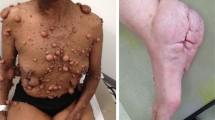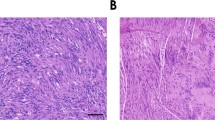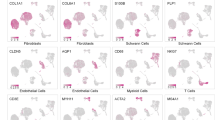Abstract
The human disease von Recklinghausen's neurofibromatosis (Nf1) is one of the most common genetic disorders. It is caused by mutations in the NF1 tumor suppressor gene, which encodes a GTPase activating protein (GAP) that negatively regulates p21-RAS signaling. Dermal and plexiform neurofibromas as well as malignant peripheral nerve sheath tumors and other malignant tumors, are significant complications in Nf1. Neurofibromas are complex tumors and composed mainly of abnormal local cells including Schwann cells, endothelial cells, fibroblasts and additionally a large number of infiltrating inflammatory mast cells. Recent work has indicated a role for the microenvironment in plexiform neurofibroma genesis. The emerging evidence points to mast cells as crucial contributors to neurofibroma tumorigenesis. Therefore, further understanding of the molecular interactions between Schwann cells and their environment will provide tools to develop new therapies aimed at delaying or preventing tumor formation in Nf1 patients.
This is a preview of subscription content, access via your institution
Access options
Subscribe to this journal
Receive 50 print issues and online access
$259.00 per year
only $5.18 per issue
Buy this article
- Purchase on Springer Link
- Instant access to full article PDF
Prices may be subject to local taxes which are calculated during checkout




Similar content being viewed by others
References
Arun D, Gutmann DH . (2004). Recent advances in neurofibromatosis type 1. Curr Opin Neurol 17: 101–105.
Bajenaru ML, Hernandez MR, Perry A, Zhu Y, Parada LF, Garbow JR et al. (2003). Optic nerve glioma in mice requires astrocyte Nf1 gene inactivation and Nf1 brain heterozygosity. Cancer Res 63: 8573–8577.
Bajenaru ML, Zhu Y, Hedrick NM, Donahoe J, Parada LF, Gutmann DH . (2002). Astrocyte-specific inactivation of the neurofibromatosis 1 gene (NF1) is insufficient for astrocytoma formation. Mol Cell Biol 22: 5100–5113.
Ballester R, Marchuk D, Boguski M, Saulino A, Letcher R, Wigler M et al. (1990). The NF1 locus encodes a protein functionally related to mammalian GAP and yeast IRA proteins. Cell 63: 851–859.
Brannan CI, Perkins AS, Vogel KS, Ratner N, Nordlund ML, Reid SW et al. (1994). Targeted disruption of the neurofibromatosis type-1 gene leads to developmental abnormalities in heart and various neural crest-derived tissues. Genes Dev 8: 1019–1029.
Castle B, Baser ME, Huson SM, Cooper DN, Upadhyaya M . (2003). Evaluation of genotype-phenotype correlations in neurofibromatosis type 1. J Med Genet 40: e109.
Cichowski K, Jacks T . (2001). NF1 tumor suppressor gene function: narrowing the GAP. Cell 104: 593–604.
Cichowski K, Shih TS, Schmitt E, Santiago S, Reilly K, McLaughlin ME et al. (1999). Mouse models of tumor development in neurofibromatosis type 1. Science 286: 2172–2176.
Costa RM, Federov NB, Kogan JH, Murphy GG, Stern J, Ohno M et al. (2002). Mechanism for the learning deficits in a mouse model of neurofibromatosis type 1. Nature 415: 526–530.
Dasgupta B, Dugan LL, Gutmann DH . (2003). The neurofibromatosis 1 gene product neurofibromin regulates pituitary adenylate cyclase-activating polypeptide-mediated signaling in astrocytes. J Neurosci 23: 8949–8954.
Daston MM, Scrable H, Nordlund M, Sturbaum AK, Nissen LM, Ratner N . (1992). The protein product of the neurofibromatosis type 1 gene is expressed at highest abundance in neurons, Schwann cells, and oligodendrocytes. Neuron 8: 415–428.
Easton DF, Ponder MA, Huson SM, Ponder BA . (1993). An analysis of variation in expression of neurofibromatosis (NF) type 1 (NF1): evidence for modifying genes. Am J Hum Genet 53: 305–313.
Ferner RE . (2006). Neurofibromatosis 1. Eur J Hum Genet [Epub ahead of print].
Gregory PE, Gutmann DH, Mitchell A, Park S, Boguski M, Jacks T et al. (1993). Neurofibromatosis type 1 gene product (neurofibromin) associates with microtubules. Somat Cell Mol Genet 19: 265–274.
Guo HF, The I, Hannan F, Bernards A, Zhong Y . (1997). Requirement of Drosophila NF1 for activation of adenylyl cyclase by PACAP38-like neuropeptides. Science 276: 795–798.
Gutmann DH, Wood DL, Collins FS . (1991). Identification of the neurofibromatosis type 1 gene product. Proc Natl Acad Sci USA 88: 9658–9662.
Ismat FA, Xu J, Lu MM, Epstein JA . (2006). The neurofibromin GAP-related domain rescues endothelial but not neural crest development in Nf1 mice. J Clin Invest 116: 2378–2384.
Jacks T, Shih TS, Schmitt EM, Bronson RT, Bernards A, Weinberg RA . (1994). Tumour predisposition in mice heterozygous for a targeted mutation in Nf1. Nat Genet 7: 353–361.
Jentarra G, Snyder SL, Narayanan V . (2006). Genetic aspects of neurocutaneous disorders. Semin Pediatr Neurol 13: 43–47.
Lakkis MM, Tennekoon GI . (2000). Neurofibromatosis type 1. I. General overview. J Neurosci Res 62: 755–763.
Levy P, Vidaud D, Leroy K, Laurendeau I, Wechsler J, Bolasco G et al. (2004). Molecular profiling of malignant peripheral nerve sheath tumors associated with neurofibromatosis type 1, based on large-scale real-time RT-PCR. Mol Cancer 3: 20.
Li W, Cui Y, Kushner SA, Brown RA, Jentsch JD, Frankland PW et al. (2005). The HMG-CoA reductase inhibitor lovastatin reverses the learning and attention deficits in a mouse model of neurofibromatosis type 1. Curr Biol 15: 1961–1967.
Mousley CJ, Tyeryar KR, Ryan MM, Bankaitis VA . (2006). Sec14p-like proteins regulate phosphoinositide homoeostasis and intracellular protein and lipid trafficking in yeast. Biochem Soc Trans 34: 346–350.
Page PZ, Page GP, Ecosse E, Korf BR, Leplege A, Wolkenstein P . (2006). Impact of neurofibromatosis 1 on quality of life: a cross-sectional study of 176 American cases. Am J Med Genet A 140: 1893–1898.
Parada LF . (2000). Neurofibromatosis type 1. Biochim Biophys Acta 1471: M13–9.
Parada LF, Kwon CH, Zhu Y . (2005). Modeling neurofibromatosis type 1 tumors in the mouse for therapeutic intervention. Cold Spring Harb Symp Quant Biol 70: 173–176.
Reilly KM, Tuskan RG, Christy E, Loisel DA, Ledger J, Bronson RT et al. (2004). Susceptibility to astrocytoma in mice mutant for Nf1 and Trp53 is linked to chromosome 11 and subject to epigenetic effects. Proc Natl Acad Sci USA 101: 13008–13013.
Riccardi VM . (1992). Neurofibromatosis phenotype, natural history and pathogenesis. The Johns Hopkins University Press: Baltimore.
Szudek J, Birch P, Riccardi VM, Evans DG, Friedman JM . (2000). Associations of clinical features in neurofibromatosis 1 (NF1). Genet Epidemiol 19: 429–439.
The I, Hannigan GE, Cowley GS, Reginald S, Zhong Y, Gusella JF et al. (1997). Rescue of a Drosophila NF1 mutant phenotype by protein kinase A. Science 276: 791–794.
Theoharides TC, Conti P . (2004). Mast cells: the Jekyll and Hyde of tumor growth. Trends Immunol 25: 235–241.
Tong J, Hannan F, Zhu Y, Bernards A, Zhong Y . (2002). Neurofibromin regulates G protein-stimulated adenylyl cyclase activity. Nat Neurosci 5: 95–96.
Trovo-Marqui AB, Tajara EH . (2006). Neurofibromin: a general outlook. Clin Genet 70: 1–13.
Vogel KS, Klesse LJ, Velasco-Miguel S, Meyers K, Rushing EJ, Parada LF . (1999). Mouse tumor model for neurofibromatosis type 1. Science 286: 2176–2179.
Ward BA, Gutmann DH . (2005). Neurofibromatosis 1: from lab bench to clinic. Pediatr Neurol 32: 221–228.
Weiss B, Bollag G, Shannon K . (1999). Hyperactive Ras as a therapeutic target in neurofibromatosis type 1. Am J Med Genet 89: 14–22.
Xu GF, O'Connell P, Viskochil D, Cawthon R, Robertson M, Culver M et al. (1990). The neurofibromatosis type 1 gene encodes a protein related to GAP. Cell 62: 599–608.
Xu H, Gutmann DH . (1997). Mutations in the GAP-related domain impair the ability of neurofibromin to associate with microtubules. Brain Res 759: 149–152.
Yang FC, Chen S, Clegg T, Li X, Morgan T, Estwick SA et al. (2006). Nf1+/− mast cells induce neurofibroma like phenotypes through secreted TGF-beta signaling. Hum Mol Genet 15: 2421–2437.
Yang FC, Ingram DA, Chen S, Hingtgen CM, Ratner N, Monk KR et al. (2003). Neurofibromin-deficient Schwann cells secrete a potent migratory stimulus for Nf1+/− mast cells. J Clin Invest 112: 1851–1861.
Yohay KH . (2006). The genetic and molecular pathogenesis of NF1 and NF2. Semin Pediatr Neurol 13: 21–26.
Zhu Y, Ghosh P, Charnay P, Burns DK, Parada LF . (2002). Neurofibromas in NF1: Schwann cell origin and role of tumor environment. Science 296: 920–922.
Zhu Y, Harada T, Liu L, Lush ME, Guignard F, Harada C et al. (2005). Inactivation of NF1 in CNS causes increased glial progenitor proliferation and optic glioma formation. Development 132: 5577–5588.
Zhu Y, Parada LF . (2002). The molecular and genetic basis of neurological tumours. Nat Rev Cancer 2: 616–626.
Zhu Y, Romero MI, Ghosh P, Ye Z, Charnay P, Rushing EJ et al. (2001). Ablation of NF1 function in neurons induces abnormal development of cerebral cortex and reactive gliosis in the brain. Genes Dev 15: 859–876.
Acknowledgements
LFP is funded by NINDS and DOD (Grant # DAMD 17-02-1-0638 & DAMD 17-03-1-0216) and ACS RP-04-084-01. We thank members of the Parada lab for helpful discussions and Stephanie Bates for assistance in the preparation of this manuscript.
Author information
Authors and Affiliations
Corresponding authors
Rights and permissions
About this article
Cite this article
Le, L., Parada, L. Tumor microenvironment and neurofibromatosis type I: connecting the GAPs. Oncogene 26, 4609–4616 (2007). https://doi.org/10.1038/sj.onc.1210261
Received:
Accepted:
Published:
Issue Date:
DOI: https://doi.org/10.1038/sj.onc.1210261
Keywords
This article is cited by
-
Schwann cell derived pleiotrophin stimulates fibroblast for proliferation and excessive collagen deposition in plexiform neurofibroma
Cancer Gene Therapy (2024)
-
Runx1/3-driven adaptive endoplasmic reticulum stress pathways contribute to neurofibromagenesis
Oncogene (2023)
-
Diagnostic difficulties and possibilities of NF1-like syndromes in childhood
BMC Pediatrics (2021)
-
The roles of GTPase-activating proteins in regulated cell death and tumor immunity
Journal of Hematology & Oncology (2021)
-
MicroRNA-155 contributes to plexiform neurofibroma growth downstream of MEK
Oncogene (2021)



